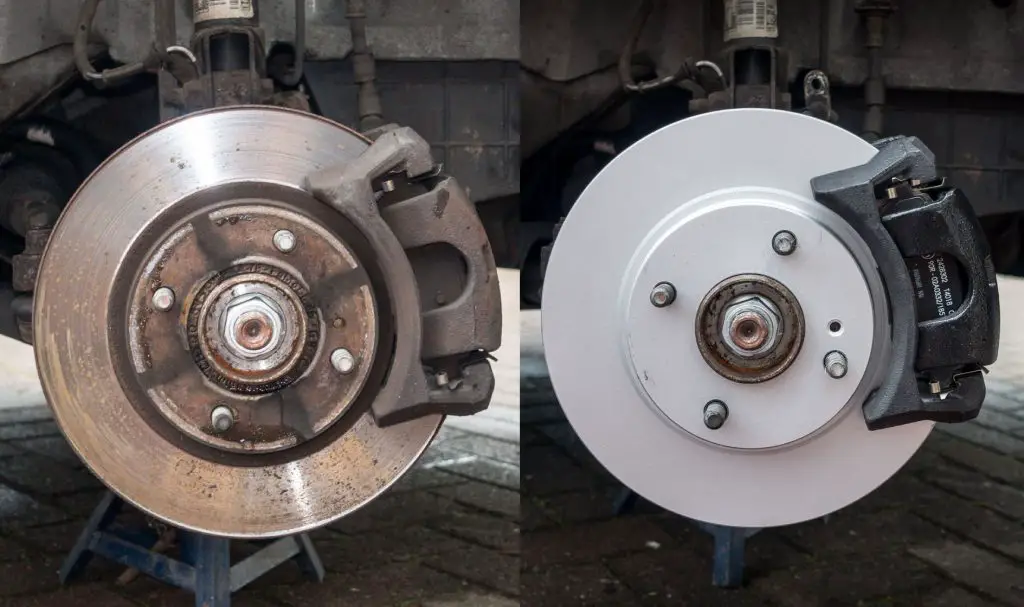Although brake caliper sticking is rare, it is critical to get it identified and repaired as soon as possible because it compromises your vehicle’s safety. When it comes to determining automotive quality and reliability on the market, safety is one of the most important factors to consider.
When we talk about safety, brakes are usually the first thing that comes to mind because they allow your car to come to a complete stop. Good brakes separate themselves from bad brakes by the quickness and smoothness with which they stop the car when you press the brake pedal.
If the brake caliper sticks when it gets hot, it can cause several complications. This could cause significant damage to the vehicle and put the occupants in danger. Understand what causes brake calipers to stick and how to fix them before taking your car or truck to a mechanic.
- What is the Caliper?
- Causes of Sticking
- When to Replace?
- How to Prevent it?
- What is the Cost?
- Final Verdict
What Is The Purpose Of A Brake Caliper?
The objective of a brake caliper is to enclose the brake pads that are used to stop your car. Your automobile or truck can slow down and stop when the brake pedal is pressed. This hydraulic force forces brake fluid through the brake lines and causes your caliper piston to push the brake pads against the rotors.
The caliper is responsible for pulling the brake pad away from the rotor when the brake pedal is removed, allowing your vehicle’s wheels to travel freely. Brake rotors are being used in an increasing number of cars on our roads, both in the front and rear.
Brake drums and shoes are used instead of rear rotors on other current cars. Any braking system’s efficacy is determined by how effectively it is maintained so that your car can slow down in any condition.

Causes Of Brake Caliper Sticking
While malfunctioning brake calipers aren’t one of the most common problems on cars and trucks, they can fail just like any other mechanical component. These are the most common causes of brake caliper sticking.
1. Worn Out Brake Hose
When brake hoses wear out, a small section of the hose breaks off and remains linked to the rest of the hose. As a result, a valve is created that only permits braking fluid to flow in one direction, preventing the fluid from returning to the master cylinder. The brake caliper becomes stuck as a result, dragging the vehicle to one side.
2. Sliding Caliper
The brake pads are held in place by grooves in the caliper that allows them to slide in and out as you apply pressure to the brake pedal. The brake pad shims might become trapped in the grooves, rusted, or clogged with debris. This will prevent the pads from sliding in and out properly, causing them to stick.
If this is the case with your brakes, you shouldn’t need new calipers. Instead, you should be able to clean them or replace the faulty shims. It’s possible that the metal groove is becoming worn out in some cases. If this is the case, the caliper assembly as a whole will need to be replaced.
3. Faulty Brake Caliper Bolts
Brake caliper bolts include lubricating slides and a protective coating to keep the lubricant in. They can, however, be damaged when new brake pads are inserted. This is worth bearing in mind if you’re trying to figure out how to replace brake pads.
Bolts can dry up and corrode, but debris can also seep in, making it difficult for the brake calipers to slide as smoothly as they should. This can lead to brake caliper sticking in extreme circumstances.
4. The Piston Is Causing The Sticking
A rubber boot covers the end of the caliper piston, keeping it lubricated and free of dirt and dust. If you install a replacement brake pad improperly or by an untrained mechanic, the dust boot might be destroyed.
This causes dust to adhere to the caliper piston, keeping it open. As a result, the brake and caliper piston will not return to its original position, instead of sticking on the braking pad.
Indications Of A Brake Caliper Sticking
After reading the top four sources of brake caliper sticking, we’ll walk you through seven of the most prevalent indications so you can tell when your brakes need maintenance.
1. Corroded Pistons And Piston Boots
The brake system would not be complete without the caliper pistons. They are pressing the brake pads against the brake disc in order to slow the car down. A rubber boot surrounds the brake caliper pistons to prevent dust and other particles from entering the brake system.
It is very usual for this boot to become broken, allowing water and other particles to enter the piston. This will cause the piston to corrode and eventually cease moving entirely, causing the brake pads to become jammed against the brake disc.
Look around the caliper boot for damage and lift it slightly to check for rust. If it’s rusted, you can remove the piston and give it a light cleaning. However, don’t forget to reinstall the boot, which might be tricky if you don’t know how. It’s typically not that expensive to replace the entire caliper, therefore that’s what mechanics suggest instead of repairing it.
2. Brake Pads That Are Rusted And Stuck
Rusty brake pads are the second most prevalent sign of a sticky brake caliper. The brake pads have greased guides that allow them to slide smoothly forward and backward on the brake caliper bracket.
If dust and rust build up on these bracket slides, the brake pads will become entrapped and push against the brake disc. Remove the brake pads, clean the brake pad bracket using a file or sandpaper. Then lubricate it with copper paste or something similar to solve this.

3. Unclean Caliper Guide Pin
When you brake, the brake caliper guide pins are placed at the brake caliper bracket and help the caliper glide forward and backward. Rust will often clog these guide pins, preventing the brake caliper from functioning properly and, as a result, causing brake caliper sticking.
Rubber boots are wrapped around these guide pins to protect them from water and dust. Remove, clean, and lubricate the guiding pins after inspecting the rubber boots. When they’ve been stuck for a while, they’re tough to get out. Use a torch to warm them up before attempting the removal.
4. Steel Cables For Parking Brakes
If your sticking caliper problem originates from the vehicle’s back, there’s a good likelihood the parking brake is malfunctioning. The handbrake on many current cars is located on the brake caliper rather than the brake disc. The handbrake wires can corrode if water or other filth gets into them.
When you disengage the handbrake, the brake calipers will not release properly. To fix it, lubricate the handbrake cable and the caliper arm, then move it back and forth a few times to check if it works. In the worst-case scenario, the parking brake wires or caliper will need to be replaced.
5. A Damaged Brake Hose
The brake hose permits brake fluid to flow from the master cylinder to the braking system. However, if the brake hose has a slight tear, the brake fluid will flow to the brake pistons but not back.
The calipers will become stuck as a result of this. This isn’t a widespread issue, but it does happen in a few vehicles. If you’ve done everything else and the problem persists, the brake hose should be replaced.
6. Brake Fluid That Is Dirty Or Old
The most common sign of braking difficulties is dirty or outdated brake fluid. Because brake fluid draws water from the air, it should be replenished every few years. If you don’t replace it, it will hold a lot of water, causing your brakes to rust from the inside out.

7. Piston Boot Torn
The dirtiest parts of your vehicle are the wheels, tires, and brakes. Dirt, grit, and debris can get past the caliper piston boot and into the piston housing if it is damaged. This dirt will then rub against the piston and its housing, causing the internal components of the caliper to wear out prematurely. This may eventually obstruct the piston’s movement. The piston may even become stuck in the housing.
How Can You Tell If Your Brake Caliper Sticking?
Every flaw has symptoms that can be used to diagnose it. These apparent signs indicate that the brake caliper is sticking.
1. Vehicle Veers To One Side
This is one of the most evident brake caliper sticking signs. The car will always pull to the side with the blocked brakes when one set of brakes is stuck, and the other isn’t. It’s easy to confuse it for a set of mismatched wheels, but you’ll be able to tell the difference.
2. The Brake Pedal Remains Low
The brake pedal staying down after you’ve taken your foot off it is another strong sign of brake caliper sticking. The brake pedal will ultimately return to its original position, but it’s going to take some time.
3. The Car Slows Down On Its Own
The brake pads are always in touch with the rotors when you have sticky brakes. This means that the car is always braking even if the brake pedal is not pressed. As a result of the automatic braking, the car will slow down on its own. This causes the brake pad and rotor to wear out faster, and you may hear brake caliper sticking noises as a result.
4. High Consumption Of Fuel
Sticking calipers could be one of the causes of your car’s poor fuel economy. Because the car will be braking frequently, the engine will have to work harder to keep up with the vehicle’s pace. This increases the amount of fuel consumed.
5. Excessive Heat Produced By The Wheels
The brake pad makes contact with the rotor when braking. The friction created by this contact causes the car to slow down. Imagine what occurs when the brake caliper is locked to the rotor if this procedure causes heat.
When the brake caliper adheres to the rotor, it generates a lot of heat, which you can feel on the wheels. After the ride, avoid touching the wheels because they will be extremely hot and may harm your hands.
6. Brake Fluid Is Leaking
When hydraulic pressure from brake fluid pushes the pistons and suspends the brake pads around the rotors, brake calipers work. A broken seal can cause a brake fluid leak, and this potentially dangerous situation can limit your ability to slow down the car.
If you suspect your car isn’t slowing down properly, have it inspected as soon as possible. Brake fluid leaks can sometimes leave wet spots on the wheels after moving from their parked position.

7. Odd Noises
Before various warning lights, braking systems were highly beneficial in notifying us when there was a problem with our cars. Fortunately, this hasn’t changed, and odd sounds when braking alone are a symptom of wear or a more serious problem.
8. Steering Difficulties
If one of the front calipers becomes stuck closed, the car may begin to pull to one side.
You may notice the vehicle pulling significantly to one side when braking if one of the front calipers is stuck open.
This is due to the fact that just one of the vehicle’s front brakes is working to slow it down. On most cars, the front brakes do the majority of the braking.
9. A Burning Smell
Check the brakes if you see smoking or an unpleasant burning smell emanating from one of the wheels. When a brake caliper becomes caught in the clamped position, it produces a lot of heat. The brake pads will melt as a result of the heat, and one wheel will heat up more than the others.
This could potentially spark a fire in some circumstances. When the rotor is overheated, it takes on a bluish tinge. It’s an appropriate idea to replace the rotors, brake pads, and brake fluid if your brakes have overheated. When brake components get hotter than they were intended to get, they lose some of their stopping power.
Is It Safe To Drive A Car With A Brake Caliper Sticking?
As we’ve discussed previously, it’s not a good idea to drive around with a stuck brake caliper because doing so is dangerous. If your car has a brake caliper sticking and you do nothing about it, various awful things can happen to you and your vehicle.
If you continue to drive in a car with a brake caliper sticking, then:
- You lose control of your vehicle and cause an accident.
- You may be rear-ended if you slow down too rapidly.
- Overworking your braking system can lead to problems with your brake pads, rotors, and other components.
For these reasons, you should never drive a car with a stuck brake caliper. A single faulty brake caliper might bring your entire braking system down with it. It also has the potential to result in an accident if you aren’t careful.

How Often Should Brake Calipers Be Replaced?
The good news is that the average car owner won’t have to be concerned about a brake caliper sticking. Brake calipers, unlike other braking components like brake pads, are built to last for a long time.
A brake caliper sticking in your car should not be noticed until it has traveled at least 125,000 miles. Your brake calipers will continue to function even after this point. Many brake calipers will never need to be replaced if the rest of your braking system is kept in good working order.
That doesn’t imply you shouldn’t look for indicators of a brake caliper sticking. The last thing you want is to be stuck driving for an extended amount of time with a brake caliper sticking. It can cause a slew of problems for you and your vehicle.
How To Prevent A Brake Caliper Sticking
Most of these issues can be avoided if you maintain your brakes on a regular basis. There are certain steps you can take to prevent similar issues in the future. Here are a few of the most common:
- Brake fluid should be changed every 2 years or more to keep the brake system from rusting inside.
- Every 2-3 years, clean the brake pads, guide pins, and pistons, or at least do it thoroughly when you change your brake pads or discs.
- Some people believe that never over-using your car’s brakes is a good thing, yet the contrary is true. If you never use your brakes hard, they will eventually become stuck.
- Many people drive short distances and never properly use their brakes. To keep your brakes from becoming entirely jammed, you should utilize them aggressively at speed a few times a year.
- Another typical mistake is that you never use your parking brake if you have an automatic transmission. When you apply the parking brake for the first time, the wires or brackets will become stuck.
How To Fix A Brake Caliper Sticking
As previously stated, dirt buildup and a lack of lubrication are the primary causes of a sticky brake caliper. To repair a seized brake caliper, you must first remove it and determine what is causing it to stick. The setup of most typical disc brake systems is similar, and anyone with a few simple tools may readily disassemble them.
- Lift the vehicle and remove the steering wheel. While working on the car, make sure to utilize axle stands to keep it stable. Remove the cap from the engine bay’s brake fluid reservoir and wrap a clean cloth around the reservoir’s opening to catch any brake fluid that may leak.
- Begin by unscrewing the two caliper bolts that secure the caliper to the brake caliper bracket.
- If the caliper is seized, it will most likely be stuck in place and will be difficult to remove from the rotor. This is where you’ll have to think beyond the box!
Examining The Brake Caliper
Push a flathead screwdriver between the brake pad surface and the brake rotor surface. Break the dirt seal between the piston face and the back of the brake pads by moving the caliper around. If the caliper is indeed seized, you may need to disconnect the brake hose from the caliper to relieve the caliper piston’s pressure.

- Remove the brake pads, brake pad shims, and slider bolts once the caliper is removed.
- Examine all brake caliper parts, particularly the rubber seal on the caliper piston’s face and any seals that cover caliper slide pins for tears or splits.
- The caliper piston seals must be replaced if they are damaged, and the piston must be removed, cleaned, and lubricated. You can either buy a kit to repair the rubber seals yourself or a brake caliper that has been completely restored.
- If the problem is dirt around the brake pad shims, use a wire brush and brake cleaner to clean everything up before reassembling. Lubricate the caliper slide pins with white lithium oil. Grease the caliper’s bolts to make the caliper’s movements smooth and effortless.
How Much Does A Brake Caliper Sticking Cost To Repair?
Repairing a seized or sticky brake caliper is rather inexpensive, especially if you do it yourself.
It can cost anywhere between $180 and $400 to replace the brake calipers with a new one. A brake caliper that has been entirely rebuilt will cost a little less. A professionally refurbished brake caliper costs between $80 and $150.
If the caliper does not need to be replaced, replacing the caliper pins and shims (sliders) on your own will cost roughly $10 to $20. A seized brake caliper might cost anywhere from $150 to $500 to repair.
Symptoms and Fixes for Seized Brakes in Vehicles
- Brakes may drag or bind when a part of the system is stuck, causing the piston or pads to seize, and may lead to reduced braking ability, uneven wear on brake pads, and pulling to one side.
- Seized brakes cause the car to feel down on power, produce a distinctive acrid smell, and may generate enough heat to start a fire, damaging discs, and wheel hub components.
- Inactivity coupled with corrosion is the main cause of brakes seizing, especially if a car is left parked outside for months, as brake discs rust and pads become stuck to them.
- Lubricating the parking brake system, removing skewed pads and applying grease to edges, resurfacing the disc and replacing pads, and using a special tool or hydraulic pressure to free stuck pistons or slide pins can help to unstick a seized brake caliper.
- Rebuilding the caliper with new rubber parts or piston is an option for DIYers and worth considering if the internal corrosion is not too bad, or a good used caliper can be rebuilt, but a brand new caliper is a simplest and wisest option if budget allows.
- Regular brake system maintenance and periodic lubrication of the handbrake cable and mechanism can prevent brakes from seizing.
Brake Caliper Sticking – Final Verdict:
The brake calipers are crucial parts of the braking system. The brake pads are clamped against the brake rotors by brake calipers. When pressure is applied, friction and adhesion forces transform the spinning rotor’s kinetic energy into thermal energy, causing the vehicle to slow down.
Without a working brake caliper, a vehicle would be unable to stop quickly at all.
The occurrence of a brake caliper sticking is extremely rare, yet it does occur. If this is happening to your vehicle, it’s critical that you know what to look for and what the likely causes are. As a result, you’ll be able to go to your local mechanic and get your brake caliper repaired or replaced as soon as possible or do it yourself.


